
UK: The Isle of Wight’s Island Line reopened on November 1, following a £26m renewal programme including the introduction of a replacement fleet of electric multiple-units rebuilt from former London Underground trains.
‘We are so excited to welcome our customers back onboard having completed the biggest upgrade to the Island Line in over 50 years’, said South Western Railway Managing Director Claire Mann. ‘The long list of benefits that come with this upgrade will give a real boost to the Isle of Wight’s public transport infrastructure, connecting communities and making it easier for visitors to explore the island.’
The first passenger service left Ryde St John’s Road station for Ryde Pier Head at 05.35, worked by two of the Class 484 EMUs.
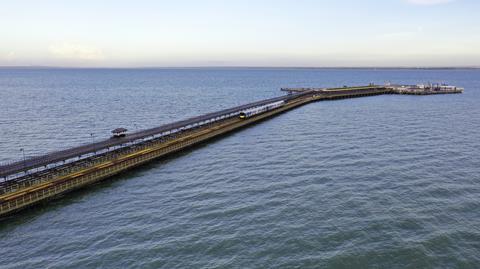
Ridership is usually low in the winter months, and the ferry service from Ryde to the mainland is currently only operating hourly, so SWR has restarted the service with just one train per hour. The operator said this would ‘allow us to provide certainty of service to our customers in the first weeks of operation, following the challenges we have faced with getting the trains into service.’
Long-term solution
The truncated remnant of a once much more extensive rail network on the island, the isolated 13·7 km Island Line linking Ryde, Sandown and Shanklin is operated by First MTR’s South Western Railway as part of the South Western franchise. However, the short and largely self-contained route is inevitably overshadowed by the scale of the franchise’s mainland operations. It has long suffered from ageing infrastructure, while the life-expired Class 483 EMUs were the oldest on the national network, dating back to 1938.
In 2015 the Department for Transport said the line carried around 1·1 million passengers/year and cost £4m a year to run against an income of £1m.
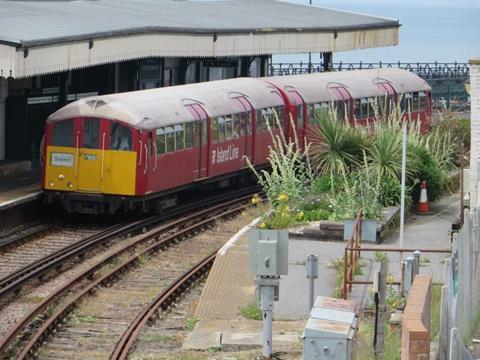
Long-running discussions about the line’s future included proposals for conversion to light rail or a combination with the island’s heritage steam railway. After what the then leader of the Isle of Wight council Dave Stewart said was ‘a long and detailed process’ aimed at securing ‘a long-term solution’, the government announced on September 16 2019 that it would provide most of the funding for a £26m modernisation.
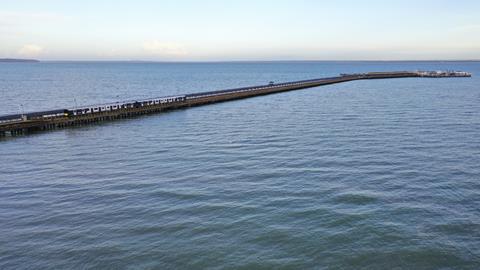
‘When I was first elected as the island’s MP in 2017, the future of Island Line was uncertain’, said local Member of Parliament Bob Seely when the line reopened. ‘Thanks to a team effort of local campaigners, members of the previous council administration, and myself, we persuaded government to underwrite this investment.
‘I am grateful to South Western Railway and the government for listening to us and I am glad to see the upgrades finally come to fruition with this significant investment. This is another good day for the island. We now have decent trains running on an improved track which will make travelling easier and more comfortable for islanders and visitors.’
Infrastructure
Services were replaced by buses from January 4 to enable what SWR said was ‘the biggest transformation to the line’s infrastructure since the line was electrified in 1967’.
The infrastructure works included track renewals to improve ride quality, power supply upgrading and the installation of new electrical and signalling cables.

Isle of Wight Council and Solent Local Enterprise Partnership contributed £1m to fund the provision of an additional passing loop at Brading, where a section of double track had been removed in the 1980s. The remaining loops had been spaced to allow a 20 min interval service, which was later reduced to two trains/h running at uneven 20/40 min headways. The line will now be able operate a regular half-hourly service providing better connections at Ryde Pier with ferries to the mainland.
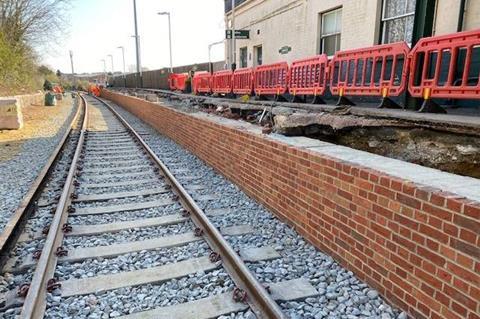
Accessibility works include raising the platforms to reduce the step onto the larger trains, while SWR has undertaken station improvements in line with its wider franchise commitments including the installation of new ticket vending machines at Shanklin, Sandown and Ryde St John’s Road and deployment of wi-fi at all seven stations.
Modernisation work at Ryde St John’s Road depot included the provision of a new crane. Zonegreen has installed three Points Converters, allowing existing hand-operated turnouts to be motorised and controlled from locally-installed key switch panels without the expense of full signalling.
Trains
The five two-car Class 484 750 V DC third rail electric multiple-units were produced at Vivarail’s Long Marston site using the bodyshells and bogies of London Underground D78 metro cars previously used on the capital’s District Line.
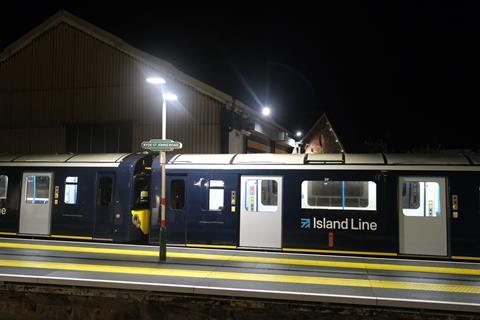
These large-profile trains replace the small-profile 1938 tube trains introduced to the island from 1989. As well as providing more space and better accessibility, they are fitted with USB charging sockets in the seats, passenger information systems, onboard wi-fi and CCTV. Open gangways allow the guards to move through the units to collect fares and assist passengers, while there is a dedicated wheelchair space and a call for aid button in each car.
The trains are being leased from Lombard North Central, which is part of the RBS Banking Group and has also funded Vivarail diesel multiple-units for West Midlands Trains.
Worth the wait
Reopening had initially been planned for March 31, but SWR said the project ‘has regrettably taken longer to complete than first anticipated’, owing to factors including train testing complications, the coronavirus pandemic and flash flooding this summer.

The first of the five EMUs was delivered to the island in November 2020, but testing subsequently brought to light what Vivarail CEO Adrian Shooter described as ‘unforeseen difficulties with the software’. Although this was similar to software used on previously D-Train conversions, some changes were needed for use with the third rail power supply.
As a result the reopening date was pushed back to May and then to November.
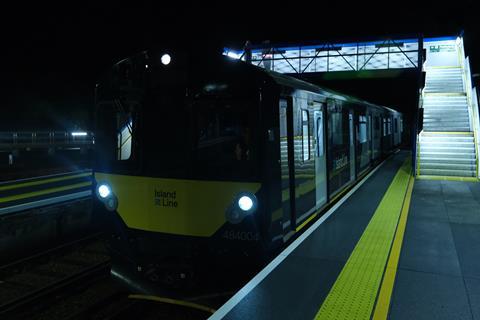
‘We’re happy the Isle of Wight will have the railway service it deserves — and hugely admiring of the work done by SWR to deliver both new trains and upgrade the infrastructure. That’s an amazing project — pulled off during a global pandemic’, said Vivarail.



